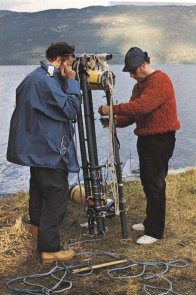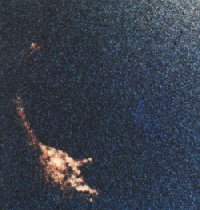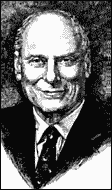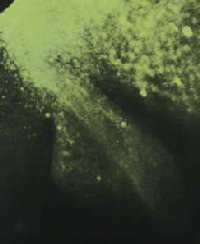
February 11, 2008

It reads like an obituary. And after a fashion, it is a pre-obit, a reflection on how it must feel as the end is in sight.

The Boston Globe looks at the final and waning days of the Loch Ness Monster hunter Robert Rines.

The article carried in today’s New England newspaper is detailed, joyous, and, I must admit, a little sad to read.

In 1999, along with my sons (one of whom has a very Scottish name and it’s his birthday today), I came upon Rines and one of his sons in a teahouse on the shores of the famed loch.
Along with meeting some other great souls there (such as Henry Bauer and Adrian Shine), talking to Rines was a high human point of my trip. He is a knowledgeable and gentle man. No one can be happy by the thought of the world of cryptozoology without Rines.

I’m glad I met him ~ specifically ~ there. The following article is a tribute that pulled a bit at my heart, I must say.

Robert Rines | Meeting the Minds
Loch Ness monster quest nears end
By Billy Baker
Globe Correspondent / February 11, 2008
In 1972, Robert Rines was at a tea party at a home overlooking Loch Ness in Scotland when his host, Scottish air force officer Basil Cary, saw something moving in the water below. Everyone rushed to the porch and, for a few fleeting minutes, watched what appeared to be a large hump with the texture of an elephant move back and forth across the water.When the hump submerged, Rines’s wife told him that he needed to find the animal again, no matter how long it took.
This summer, like nearly every summer since then, Rines is going back to look for the fabled Loch Ness monster. He’s 85 now. The rest of the tea party is gone. And he thinks “Nessie” is gone, too.
Rines believes there were at least two Nessies alive in the murky depths of Loch Ness in the ’70s, when he took a series of underwater photographs that are perhaps the best physical evidence yet to support the existence of a large unidentified animal. But Rines’s sonar hasn’t picked up any of the large moving objects since the mid-1980s, and eyewitness accounts have dropped off significantly.
So now, he’s chasing skeletons, or at least spots on a sonar map that he hopes will turn out to be a great beast’s remains.
As he unfurls a sonar map of the loch and lays it out on a conference table in the “Nessie Room” of his apartment in the Harbor Towers, Rines points to 100 suspicious spots. He checked out five last year, before he had a stroke. His recovery is going well and he’s ready to go back and look at the rest. But he says it’s his last chance.
He’s out of ideas. “And I’m running out of age, too,” he says.
Rines is probably the most accomplished person to try to prove to the scientific community that Nessie is – or was – real.
Several rooms in his apartment are stuffed with videotapes, binders, photos, and honors from his various careers as a patent attorney, physicist, inventor, MIT professor, Broadway composer, law-school founder, and World War II veteran.
Rines points out that his Nessie expeditions haven’t just been about searching “for a needle in a mountain of hay stacks”; the dark waters and extreme depths of Loch Ness have provided a great testing ground for many new technologies.
“When you get a bunch of people together who are searching for an elusive goal, the minds come together and you end up discovering a whole bunch of other things,” said Alex Slocum, a mechanical engineering professor at MIT who accompanied Rines on an expedition in the ’90s to build camera frames that would allow them to film on the bottom.
Rines’s expeditions have fostered “a whole plethora of new ideas in areas like how to deploy underwater video and how to look through the murky water,” Slocum said. “In that regard, it doesn’t matter if Nessie is there or not.”
The Loch Ness Monster has captivated the world since the 1930s, when eyewitness reports of a large, dinosaur-like animal began spreading from a remote area in Scotland. Believers and debunkers have been making pilgrimages to the Scottish Highlands ever since, and the legend has suffered more failures than successes, including a deathbed confession in 1992 revealing that the most famous photograph, of a creature with an elephant-like neck sticking out of the water, was a hoax.
Rines himself wasn’t sure there was anything to be found in the loch when an MIT colleague, Harold “Doc” Edgerton – who earned international acclaim for his advances in flash photography – asked Rines to bring his sonar expertise to the search in 1971.
Within 15 minutes of putting sonar equipment in the loch, they detected large moving targets. Rines was intrigued and returned again the next year, which is when, he says, “I had the misfortune of seeing one of these things with my own eyes.”
Rines had some success with underwater photography, including a 1975 picture of what appears to be the body, flipper, neck, and head of a large animal, but Nessie’s trail went cold in the 1980s and Rines believes the last of the creatures has since died.
Joe Nickell, coauthor of “Lake Monster Mysteries” and a Nessie doubter, said he’s certain that Rines believes that his 1975 image shows Nessie, “but it takes a good deal of imagination to see what he wants us to see. It’s like a Rorschach test. It could be anything.”
Though Rines has yet to find the irrefutable evidence that skeptics demand, there have been some bright spots to support his theory that Nessie existed. Six years ago, he discovered evidence that the sea once reached to the freshwater loch, which supports theories that Nessie is the descendent of a large ocean animal. And then, last year, his underwater cameras captured an unexpected life form – a common toad, 324 feet down, surviving well outside of its known habitat. Finding that remarkably misplaced toad, he says, suggests that perhaps Nessie could have lived far from its native habitat – and gave him a new lease on his quest.
“Admiral [Robert] Peary had to make 28 trips before he got to the North Pole,” Rines said, with a bit of fire in his eyes, as he looked down at a table covered with his Nessie history. “What am I to do, forget what I saw?”
Rines leaned back in his chair and surveyed the photos in front of him.
“There are a lot of eyewitness accounts. Are they all liars? All drunks? I don’t believe that about human nature,” he said. “What disturbs me as a lawyer is that we prove cases by eyewitness testimony. The human brain is not 100 percent accurate, but it’s not zero, either.”

FACT SHEET
Hometown: Born in Brookline; has lived in the Harbor Towers since they opened in 1971.
Education: Bachelor’s in physics from MIT in 1942; law degree from Georgetown University in 1947; doctorate in physics and microwave technology from Chiao Tung University in Taiwan in 1972.
Family: His wife, Joanne, is the former editor and publisher of Inventors Digest. Son Rob is a lawyer in New Hampshire; daughter, Suzie, runs a feral animal clinic in Duxbury; son Justice ran a record company in New York until recently.
Broadway bound: Rines has composed the music for several Broadway shows, including Sean O’Casey’s ‘‘Drums Under the Windows,’’ August Strindberg’s ‘‘Creditors,’’ and Eugene O’Neill’s ‘‘The Long Voyage Home’’; he shared an Emmy in 1987 for his composition for the television production of ‘‘Hizzoner The Mayor.’’
Other Distinctions: In 1963, he founded the Academy of Applied Sciences; in 1973, he founded Franklin Pierce Law Center; in 1994, he was inducted into the National Inventors Hall of Fame and the US Army Signal Corps Wall of Fame.

About Loren Coleman
Loren Coleman is one of the world’s leading cryptozoologists, some say “the” leading living cryptozoologist. Certainly, he is acknowledged as the current living American researcher and writer who has most popularized cryptozoology in the late 20th and early 21st centuries.
Starting his fieldwork and investigations in 1960, after traveling and trekking extensively in pursuit of cryptozoological mysteries, Coleman began writing to share his experiences in 1969. An honorary member of Ivan T. Sanderson’s Society for the Investigation of the Unexplained in the 1970s, Coleman has been bestowed with similar honorary memberships of the North Idaho College Cryptozoology Club in 1983, and in subsequent years, that of the British Columbia Scientific Cryptozoology Club, CryptoSafari International, and other international organizations. He was also a Life Member and Benefactor of the International Society of Cryptozoology (now-defunct).
Loren Coleman’s daily blog, as a member of the Cryptomundo Team, served as an ongoing avenue of communication for the ever-growing body of cryptozoo news from 2005 through 2013. He returned as an infrequent contributor beginning Halloween week of 2015.
Coleman is the founder in 2003, and current director of the International Cryptozoology Museum in Portland, Maine.
Filed under Breaking News, Cryptotourism, CryptoZoo News, Cryptozoologists, Cryptozoology, Expedition Reports, Eyewitness Accounts, Lake Monsters, Loch Ness Monster, Men in Cryptozoology, Photos, Pop Culture